#Because references to Norse mythology
Explore tagged Tumblr posts
Text
Idk if anyone is up for it but I have a RotBTD genshin impact au and I will makes a whole post of all the stuff that's going on in my head so far
#rise of the brave tangled dragons#So far all I know is that#Elsa is cryo zhongli#Or dogli#Because references to Norse mythology#And isabela Madrigal suffers childe syndrome#She just wants to learn how to use a bow#But geo cat adeptus dude puss said no#rotbtd
14 notes
·
View notes
Text
i think more heimdallr designs should give heimdallr horns that are not just part of his helmet. i mean thats just me liking to take things literally based off a vague maybe incorrect translation of hallinskiði but i do like to see him him resembling a ram because. i just do
#fish.txt#headcanon that when he is angry/upset etc etc he just bashes his head into things repeatedly because he can actually get away with it#actually reminds me how his sword is also said to be his head huhh...#norse mythology tag#well technically it's 'man head' but iirc in that one poem whos name i can never spell his sword is referred to as 'heimdalls head' so
4 notes
·
View notes
Text
kennings can be such a tender thing
they can also be kind of rude
#norse mythology#read a thought that kennings are used so abundantly because people were that familiar with the stories#haven’t been the same since#i’ll be reading a poem and they’ll call loki ‘thor’s friend’ one line and randomly ‘the coward’ in the next#love all the different names…#they called thor ‘the giantess’s friend’ which is Different. in a good way#whenever i read kennings for sigyn i lose my mind a little#i i need more poetry. and prose as well. i need it all. i need to learn every ancient language and also some modern ones immediately.#‘gold is called- [lists ninety things]” hel YEAH it is tell me all about it#‘here is how to periphrase xyz’ and then you tell me a story explaining why?? thank you snorri this is all i need in life#shout out to that one guy who interchangeably used ‘loke’ ‘loptur’ and ‘loðurr’ in his poem. and then also called utgard-loki ‘loke’-#—in the second half. inclusion of lodurr (who is often regarded as a Different Guy) really packed it in xD but the translators clarified-#-‘Asa-Loki’ in the annotations which was nice#i like when they use odin-names to mean ‘god’#or when they use anyone’s name in other context to mean warrior#and how that poet uses several random jotun-names interchangeably to refer to it utgard-loki’s disguise#anyway#kennings are cool#define them by their relationships and feats and stories i am SO here for it#ALSO THEY USED ‘sons of goats’ TO MEAN. YOU GUESSED IT. GOATS
6 notes
·
View notes
Text
of course it's perfectly fine to point out the many, many ways in which the thor movies do not represent norse myth in order to teach people what norse myth actually is, but i will sincerely never understand people who do it to like... complain? that mcu thor is "inaccurate" and "bastardised"? like my friend that's quite literally the entire premise. look at him. he has a laser gun. he was a baby during the viking age and if you call him a god he's going to laugh at you. he doesn't know who baldr is. what gave you the impression that mythological accuracy was ever on the table? the mcu isn't even interested in being accurate to the comics.
#space viking tag#[buying a ticket to the reimagining mythology as a modern scifi drama movie] theyd better not be reimagining any mythology in here.#like it's just... idk they're still using the names but it is SO FAR removed that this criticism just makes no sense.#oh no! i can't believe jessica would BASTARDISE the original barbie canon by making her barbie brutally murder her sylvanian families!!#'well actually it does matter because marvel is most people's reference point for norse myth-' okay. make another movie.#if you wanna teach ppl about norse myth be my guest! but 'inaccurate' depictions are not like. a violence. they don't need to disappear.#it is not morally wrong to fuck around with a story a little it just isn't. sorry ��\_(ツ)_/¯
4 notes
·
View notes
Text
>_>
#I want to complain in detail about how flat skyrim's references of norse mythology are#and how even after SEVERAL releases over the course of a decade#they still never fleshed any of it out other than visual design#while also they couldn't even have the decency to multi-dimensionalize#the horrors and awfulness of the Nords (stormcloaks; bandits and imperial nords) racism in something that's compelling to engage with#and instead is still a flat ass two dimensional fantasy derivative view of a mythology and pantheon#and the conflicts within said main themed group of people about why they just actually hate everybody#TEN YEARS AND SEVERAL RELEASES#...so yeah Bethesda is still king (derogatory) of failing to understand the source materials they reference from#but yeah I can't complain about it because my brain fries out every time I try#and modding the game hasn't helped much in that regard#cos no matter how many fleshed out and nuanced stuff modders make about the nordic aspects of the game#the base game itself is just that fucking Bad#I know there's essays already written about all this...#still pisses me off tho that I can't put my own experience down properly without my thoughts scattering into the fucking void#over ten fucking years and several releases later jfc
0 notes
Text
God the loss of Loki's mind is such a good catalyst for the plot of the bifrost incident. Here's one of the most immediately recognizable figures in Norse myth. You know who she is even if you know nothing about mythology because of the endless pop culture portrayals of her. You hear her name and you know exactly what to expect. But the narrative will not give you what you expect. Because she's not Loki, not really, not anymore. And that absence is felt so severely by Sigyn and Thor that even after seeing her alive they continue to refer to her as if she's dead. By the way the first thing you hear about her is that she was supposed to be dead already. By the way she was destined to die from the start. By the way Loki is a ghost haunting her own body and a gaping wound in the lives of everyone who ever knew her. Three cheers for existing as an echo of your former self! Three cheers for trying desperately to recapture memories of a life you are afraid of living! Three cheers for Loki!
768 notes
·
View notes
Text
Updates to AO3 "Mythology" Fandoms
Hi AO3 users! You may have noticed that recently, fandoms previously canonized as "Mythology" are being updated to "Religion & Lore". This renaming project is part of a wider ongoing process on AO3 about respectful treatment and naming of various religions, spiritual beliefs, faiths, and collections of folklores belonging to a particular religious or cultural tradition. This includes both major and minor religions, as well as reconstructionist, ancient, and modern religions.
In the coming months, the term "Mythology" is being phased out of canonical fandom names. This is because of its potential for use as a disparaging term, and the way in which it is used primarily for religions which are already under-represented. Since "mythology" has connotations of being fictional or inferior to the religious beliefs of the speaker or writer, and is unfortunately used in this way by some, the decision has been made to replace this term with something that the Wrangling Committee believes is more inclusive and less derogatory.
After extensive discussion between individuals from varying religious backgrounds and beliefs, including wranglers representing the various fandoms which were being covered, it was felt that "Religion & Lore" was an appropriate and neutral way to describe the bodies of faith, belief, knowledge, and tradition associated with many of these religions which were ancestrally imparted and regional in nature. It is also hoped that this will decrease ambiguous or confused use, allowing people to more accurately describe their works and find works in which they are interested moving forward.
The use of "Ancient" in many of these fandoms' names reflects that these countries still exist but now have different predominant religions or spiritual beliefs. For example, Ancient Greek Religion & Lore (as Greece is now a predominantly Christian country) or Ancient Egyptian Religion (as Egypt is now a predominantly Muslim country). Because "Norse" does not refer to an extant country, region, or culture, it is not necessary to specify that it is historical or ancient in nature.
The names of these fandoms will also have the native language piped, if the English-language demonym is significantly different from the native-language demonym or if there is a culturally specific term based on consultation with individuals who speak these languages as a first language. We hope to give representation to the language of the source culture by doing so.
Each of these changes has been and will continue to be carefully researched and discussed with traditional knowledge keepers and researchers from the cultures represented in the fandoms under discussion.
Many religions face the issue of texts being written long after their events occurred. Unfortunately this is something which is shared across many religious fandoms; AO3 seeks to treat these religious fandoms equally. Care has been taken in researching characters relating to these fandoms, and character tags will be canonized or made a synonym on a case-by-case basis. Fandom tags that are currently synned to the Ancient religious fandoms have been checked as thoroughly as possible to ensure that they are not referring to modern folk tales, and where possible such relatively modern folk tales are canonized as their own fandoms.
(From time to time, ao3org posts announcements of recent or upcoming wrangling changes on behalf of the Tag Wrangling Committee.)
5K notes
·
View notes
Note
Hello Dapper. I don’t really expect too much about this, but do you have any ideas for Wargs? They have an interesting relationship with goblins and are weird in that they’re essentially sapient wolf monsters, but I don’t think they’re ever really used that creatively.
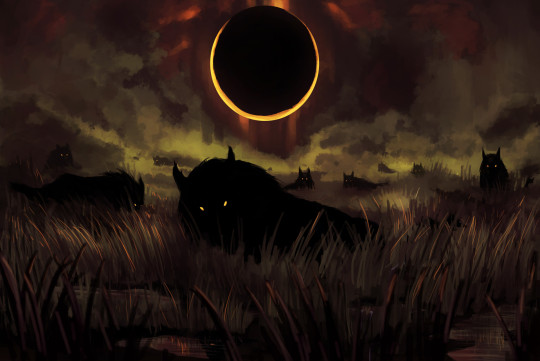
Monsters Reimagined: Wargs, wolf panics, and the Economics of Lupophobia
While the surface level answer is pretty simple (warg is a conversion of varger, an old Norse way to refer to mythological wolves like Fenrir) there's actually a surprising amount of material to drill into here on the topic of sapient wolf monsters, especially for someone like me who has a interest in moral panics and mass hysteria events. Wolves were effectively a boogyman for pre-industrial societies, a deep seated generational fear that we only recognize today through cultural relics like the big bad wolf or boy who cried wolf.
TLDR: If you want to do something interesting with wargs beyond just "wolves that talk" I'd advise playing to their folk / fairytale roots. They're creatures of embodied dread, drawn from the stuff of the feywild to sow fear among those who would travel off the path or too close to the wilderness. This lets you tell interesting stories about how the party/major characters respond to fear: Does fear of being attacked in the dark drive the party to make risky decisions that might endanger their quest? How do the villagers react when the wolves are very literally at the door, demanding just one of their neighbours as a meal in exchange for safety?
I'd also advise getting weirder with a warg's powers, playing into that fear of the unknown by doing unexpected things. The party can fight off a pack of wolves, sure, but what does it mean when the lead wolf rips off the bard's shadow and takes off into the night?
Background: If you want a window into the headspace of wolf-panic, think about the neigh omnipresent fear of sharks created by the Jaws franchise. Children who have never seen the movie, let alone seen a shark in person can become irrationally afraid of getting into deep water because they've absorbed the pervasive cultural phobia, which goes onto shape environmental policy as sharks are overhunted or killed out of spite for their perceived threat.
So it was for wolves, even after they were largely hunted to near extinction by medieval and postmedieval societies, the fear of them was so ingrained into cultural traditions that wolf and werewolf panics were a thing that went hand in hand with witchtrails. France had a country wide one as late as the 1760s and the movie based on it ended up inspiring Bloodborne. Alternatively look at the anti-wolf efforts during the colonization of the Americas, right up to the opposition to reintroducing wolves back to Yellowstone park.
On that note (and because we can't have a Monsters Reimagined without some kind of class analysis), lets talk about how these fears are propagated: On many levels it makes sense for everyday people to be afraid of wolves, they're a hunting species that can absolutely pose a danger to us, and when you're living or travelling outside the protection of a settlement you really are vulnerable to a coordinated pack of carnivores running you down.
However, the primary threat that wolves pose to humans isn't predation, it's property damage, specifically in how they kill livestock. While we can talk about individual farmsteads beset by beasts, in reality the herds that wolves were most likely to prey upon belonged to the landowning classes, powerful people who had a profit incentive in seeing wolves driven off or exterminated. This is where you get bounties on dead wolves, not just paying for the value of the hide but actively rewarding people for going out and killing as many wolves as possible to the point of it becoming a profession. This practice has existed for MILLENIA and is still active today, primarily in places where big agriculture influences governments.
It seems incidental at first but then you realize that it fits the model of just about every other kind of cultural panic: widespread ignorance and fear that just so happens to mobilize the populace in a way that financially benefits a select few. You can see the same thing happening today in england with badgers of all things, which have been identified with the local dairy industry as a threat to their herds. This is not only led them to petition the government to cull the badger population, but to put out anti-badger propaganda, eventually turning it into a culture war issure to the point where conservative mouthpieces like Jeremy Clarkson openly encourages killing and gassing badgers on sight.
Returning to the land of fantasy for now: I think it's worth taking the idea of the warg and mixing it with a few other "black dog" cultural archetypes, which can also include the creatures like the shuck or church grimm. In this instance the warg is a sort of curse made manifest, the fear of a haunted place given literal teeth. People who transgress into these forbidden spaces find themselves pursued by a manifestation that dogs them till they're exhausted and vulnerable, much like a wolf harrying its prey.
The bhargest is also of special interest here, considering how I like to relate goblins back to the feywild. You could easily see bhargests as agents of fey that feed on human fear, leading a pack of goblins or hobs that occupy the desolate lands they've called to haunt. My version of Maglubiyet would also delight in employing such creatures as his emissaries.
Going back to the vargr/ Norse mythology angle, it's interesting that most of the wolves that show up are destined to devour something, whether it be a god or celestial certanty like the moon and sun. It's like the concept of an inevitable chase is so fundimental to what a wolf IS that it became a theme of ragnarok's inevitable certantly. Consider having certan packs of wargs be offspring of some fenrir style god eater, beasts of forboding doom who's mere presence is an omen of ill times.
Alternatively, if you wanted to play on the big bad wolf angle, give wargs the ability to take on flimsy human disguises, all the better to get close to their pray and sow fear among the townsfolk. Historical wolf panics after all are not all that different than serial killer panics, and it'd be a fun twist on a traditional werewolf adventure to have the party on a creature that didn't play by the usual lycanthropic rules.
Artsource
213 notes
·
View notes
Text
Subtext and Culture, Young Royals, Season 3, Episode 3
Episode 3 picks up the day after the camping trip, and Wilhelm calls his mom to check on her. She dumps a massive guilt trip on him, maybe unintentionally, and Wilhelm is feeling a little bit down.

Culture: These are Swedish studentmössor. They originated in the 1800's among Nordic university students and they wore them as a common marker. Later, they were adopted as graduation caps for high school students, signifying that they were now allowed to begin studying at a university.
Culture: Valborg, April 30th, is a traditional Swedish holiday where you celebrate the coming of spring with bonfires. It is also the start of graduation season for high school students, and graduates are allowed to start wearing their caps.
Cinematography: This season they started writing most on-screen social media commentary in English, despite those users being pretty obviously Swedish. I suspect it's because it saves them having to subtitle all of them, it makes it a bit easier for all the viewers to follow along.
Subtext: No, keeping up appearances is more important than mental health for the royal family, which is why this is new behaviour that Wilhelm has never seen before.
Subtext: As a reminder of the increased interest, here's a paparazzi intruding on school grounds. Also, where the hell is Malin? Isn't it her job to shoo away photographers?
Culture: Vintern Rasat is a classic Swedish song celebrating spring that's often performed by student singers at Valborg.
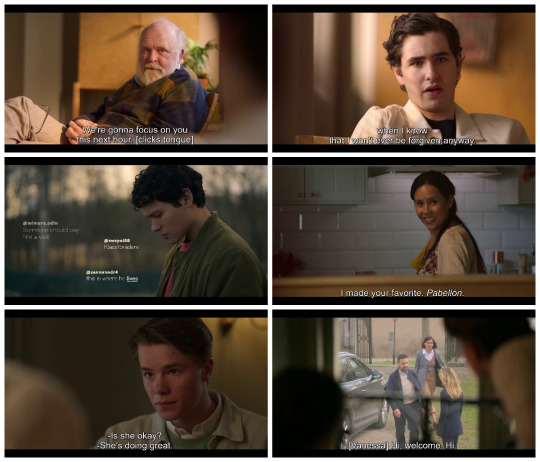
Subtext: Boris cleverly offers August individual therapy, something he sorely needs.
Subtext: It's of course a bit ironic that pretty much the entire fandom hates August and has decided that he can't be forgiven or redeemed. Yes, you, dear reader. But Boris lays out a way for August to start his redemption arc. Will it work? Tune in for next week's episode!
Culture: These usernames reek of white supremacy. Norse mythology references are very popular, and 88 means H*il H*tler, so that's the kind of people we're dealing with. The show is also foreshadowing what's gonna happen at the end of the episode.
Blink and you miss it: Linda made Pabellón, a Venezuelan dish. In season 1 we didn't know where Linda was from, but in season 2 she was canonically made as being from Venezuela, just like Omar is in real life.
Subtext: I think August actually cares, Kristina is family to him too, but Wilhelm refuses to treat him as family, so he lies about how she's doing. Not very convincingly, though.
Cinematography: This is an absolutely hilarious shot with a bunch of students anxiously peering out through the windows as the dreaded enemy arrives: Skolinspektionen! Dun-dun-dun!
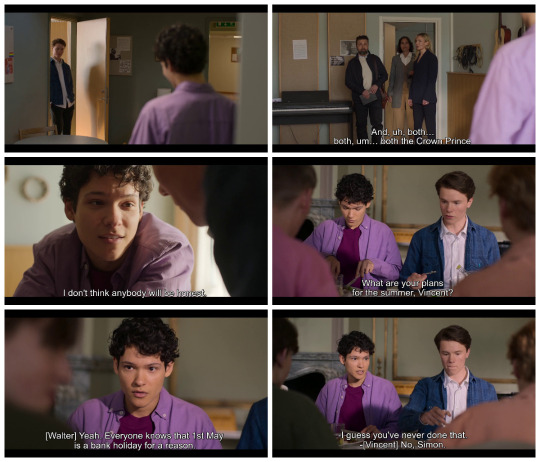
Blink and you miss it: There's a rainbow flag on the board to the left.
Subtext: Vanessa totally knew she interrupted a makeout session between our boys. Oh, and there's a lot of purple in these two scenes, colour theory exploded with joy.
Subtext: Simon will be proven wrong, someone will be honest.
Subtext: It's also ironic that Simon joins the rest of the Forest Ridge boys pretending to have a great meal together that is totally not stiff and awkward at all, absolutely not.
Lost in translation: Simon Walter says that May 1st is a "röd dag" - a red day, which is how Sundays and public holidays are usually marked in a Swedish calendar. "Bank holiday" is the term used in the UK for public holidays. There are 13 public holidays in Sweden each year.
Culture: Första Maj is the name of the International Workers' Day in Sweden, because it always occurs on May 1st. In defence of Henry and Walter's shared braincell, most Swedes actually don't participate, but it's a bit weird to not even know what it is.
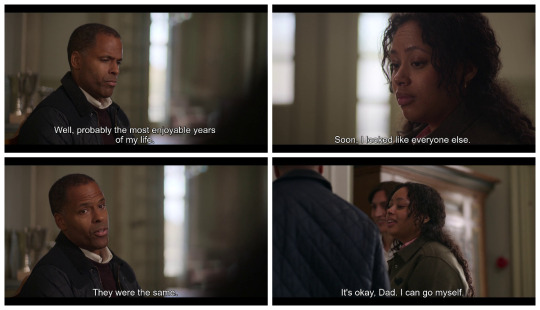
Subtext: This entire sequence shows how Felice's dad tried to stick up for himself, but quickly learned to keep his head down instead and conform and roll with it. And it wasn't just the other students who were racists, the staff was in on it too. This goes for all the shit the students are doing, the partying, the booze, the alcohol, the bullying: The staff is in on it. They know. They're complicit.
And despite all of this, Poppe's immediate answer when asked how his time at Hillerska was, is that it was the best time of his life. This is why schools like this stay the way they are, why they never change, because they're very good and very bad at the same time. Trauma-bonding works, the kids will all get friends for life, they'll forget the shit and remember the good times. They'll become like him.
But when Felice learns what the school did to her dad, she decides to help shut it down, to stop the cycle of abuse. The reason she goes in alone is because she now knows she can't trust her dad, he's gonna defend the school, and she also doesn't want him to know that she snitched.

Subtext: In official surveys, students from schools like this generally rate them very highly. Student satisfaction is very high. Maybe they're lying, maybe they're delusional, but they sure care more about their schools than public school students.
Blink and you miss it: REAL SUBTLE THERE, SHOW.
Subtext: Keeping with the school theme, this is how students defend the shit that goes on. Outsiders are kept in the dark, you don't tell them anything, because they "wouldn't understand", they're missing the "full context", etc. Oh, I don't know shit about fashion, but Fredrika's jacket smells very expensive.
Blink and you miss it: While Wilhelm pinned a polaroid of himself and Simon prominently on his wall, August keeps a similar polaroid of himself and Sara hidden.

Subtext: Micke's redemption arc is in full swing, so why not play a song that reinforces the idea that people can change?
Subtext: August's redemption arc is in full swing, so let's cut to him nervously waiting outside Micke's place for Sara to come home, while the same song is playing. Is he gonna be a villain forever?
Blink and you miss it: Micke introduces himself as Micke af Eriksson when August introduces himself as August Horn af Årnäs. The English subtitles for some weird reason went with "Micke Eriksson of Bjärstad", but that's actually not what he says.
Subtext: Sara is pretty realistic about her expectations of her dad because she's seen this before, but this also applies to her expectations of August, because she knows that he can also slide back into his normal shitty self. Also, she's wearing a purple sweater.

Subtext: In case you forgot, August's dad also struggled with addiction, and died from it, so he and Sara actually has that in common. Maybe there's hope for this redemption arc thing?
Cinematography: I don't fucking know why they included this baking scene. It serves no purpose, and I suspect quite a few people in the production have a serious hand fetish, because what is this? What is this? Also, why are Simon and Wilhelm joining what appears to be a Manor House thing with the rest of the girls? How? Why? This makes no sense! It's very cute, though!
Subtext: Oh ok, we got a social media pic that Sara could see and feel bad for her lost friendships. But man, those Hillerska aprons! On point!
Subtext: This is unfortunately a very common thing for people on any kind of psychoactive medication. How can you tell if you need medication if you feel good right now? Is it lasting or temporary? Can you trust your own brain? Either way, fantastic conversation between Micke and Sara, which starts her on her journey to reconcile with Felice at least.
🎵 I can change, I'm not the same, not forever. 🎵
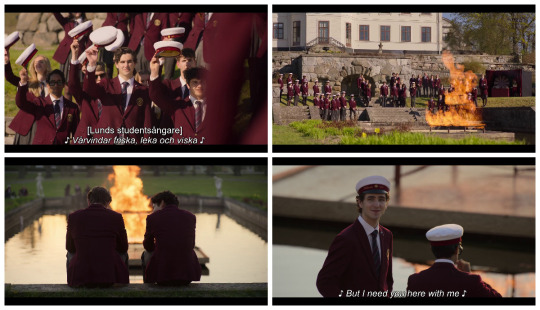
Culture: The official hat-on-putting ceremony where all the third-year students put on their hats, set to another traditional Swedish spring celebration song: Vårvindar Friska.
Culture: It's Valborg, so Hillerska has their own little bonfire. We saw some students with torches pretending to light it, but it's actually floating in the middle of the fountain so, uh, how did they do that? Normally, your local bonfire or Majbrasa is just a huge heap of wood that you set on fire.
Cinematography: Man, this is a pretty show. Look at that shot. The fire, the sunset, the pool reflection. The end of April is over a month after the spring equinox, so the days are getting longer, and the sun now sets at about half past nine in the evenings.
Subtext: Ok, let's do one more on-the-nose lyrics thing for when August sees Sara back at school. Yes, yes, he needs her.
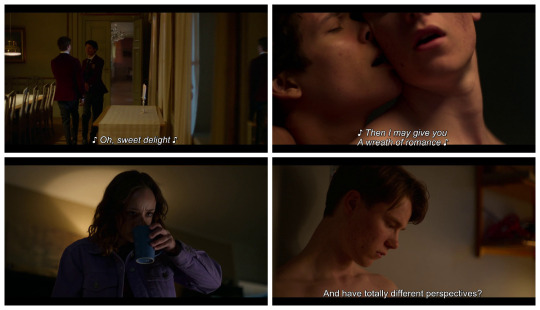
Culture: I had to post about it immediately after watching the episode, because setting a sex scene to Uti Vår Hage is hilarious. Everyone in Sweden knows it, most people have sung it at school, it's a cute little song about enjoying your garden, flowers, and giving your loved one a wreath of flowers. I can now never hear this song without thinking about this scene. Thanks a lot, show.
Blink and you miss it: Simon fucks Wilhelm. Yay! Versatile supremacy!
Subtext: Sara is still so suspicious of her dad's behaviour, she can't make herself trust that his current good period will last.
Subtext: Even though this dialogue is about how Simon and Sara are so different, it of course also applies to how Wilhelm and Erik were different, because Wilhelm struggles with not being able to handle his duty the same way Erik could.

Culture: Alright, it's time for the actual local Första Maj event in Bjärstad. The town is probably a bit small to have a proper demonstration parade, but there's people with banners and socialist slogans, and a bunch of local organisations have joined in, including Bjärstad BK, the football club Rosh plays in.
Culture: Meanwhile, the absolutely not socialist rich kids at Hillerska are nursing their hangovers and enjoying the day off, and they're doing some yoga and playing some padel instead. As you do.
Subtext: Drugs. He looks like he's selling drugs.
Culture: These apparently confused a bunch of viewers, but they're just raffle tickets. It's one hundred numbered, rolled up, paper tickets stuck on a metal ring. When you buy a ticket you just tear it off at the perforation, and when all tickets are sold you can just break the seal on the ring and pour all the stubs in a bag or whatever so you can draw winners.
Blink and you miss it: Cute kiddo has a pride pin on his jacket.
Lost in translation: The show waited a bit with showing what it says on the banner behind them in the photo, but if you can read Swedish you immediately saw that it says KROSSA ÖVERKLASSEN - CRUSH THE UPPER CLASSES. Oh no, Simon, what have you done?
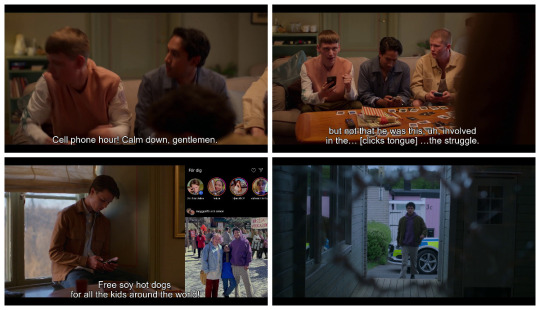
Blink and you miss it: Like a pack of rabid wolves, the social-media starved Gen Z kids rush to their phones for an hour of glorious feeding on Instagram and TikTok.
Blink and you miss it: I love Vincent so much, he's terrible, but he's just so much fun! The little fist he makes as he says "kampen" just seals it.
Subtext: The show still hasn't revealed the banner text to the non-Swedish audience, but Wilhelm immediately sees it and knows how bad it is and why Farima tried calling him seven times. Also, Vincent is just on a roll here.
Cinematography: Man, this is a pretty show. Look at that shot. Look at how they perfectly aligned the hole in the window with Simon, the police car, and the entrance to their house, as he discovers that someone decided to vandalize it.
243 notes
·
View notes
Text
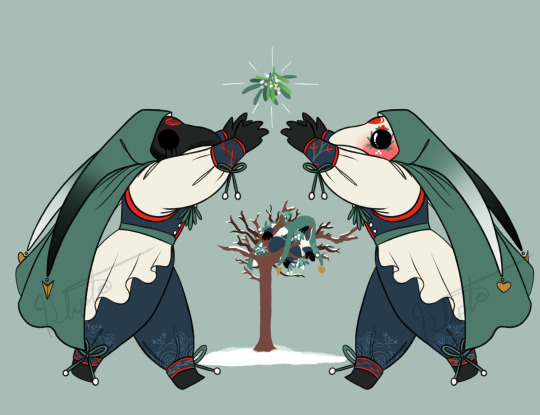
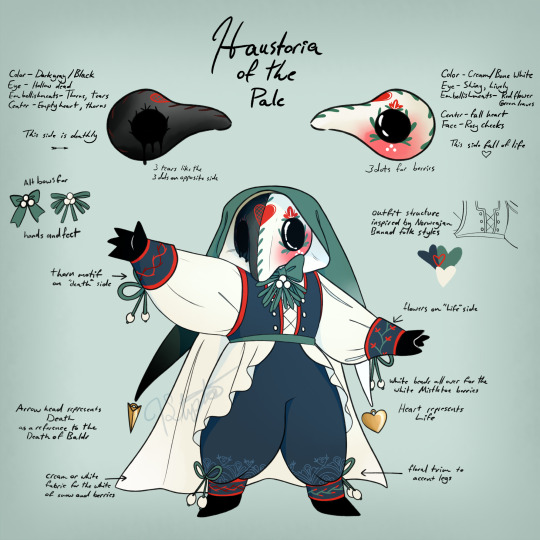
You’re walking down a long quiet road. It’s winter, snow covers the ground, the sky fades gray. All around you are trees that have long since dropped their leaves, cold and dead, waiting for spring. You stop beneath one, eye caught by a striking sight. Amid the bare branches you see a round bundle of stunning green leaves. Hanging down above you are dozens of beautiful little pearly white berries. The fruit tempts you, but you don’t dare touch. Instead you simply admire them. Life among the dead of winter. Mistletoe.
@slocotion Hi, here is my design for slocotion's patreon dyo doll contest. Her name is Haustoria of the Pale. I was very excited to put this together once it struck me. I thought of all my favorite fruits I could have used but then inspiration hit me as I was considering less common fruits and fungi. Mistletoe is used medicinally by some but the entire plant, including its cute white berries, is toxic. Since this is a longer post, I’ll include more notes on my design under a cut but to point out the most important thing, I’ve combined the nature of the toxic berries with some historical+mythological inspiration that I think echoes it nicely.
In Norse mythology, a well known story is that of the death of Baldr. Baldr was the most loved god of the Aesir, so when a vision of his death reached his parents Odin and Frigga, they did all they could to protect him. Frigga sent her servants all over the world to make every creature and thing vow to never harm a hair on Baldr’s head. All but mistletoe promised, too insignificant or too young to make the vow. After it was done, Bladr seemed invincible. Since nothing was willing to hurt him, the gods would sometimes gather around and throw things at him, watching everything bounce off without injuring him. Loki, jealous of the love and affection that was always paid to Baldr, came up with a plan to get rid of him. He had an arrow made of mistletoe and brought it to Baldr’s blind brother Hodr. He gave it to him to throw at Baldr as all the gods pelted him with objects and weapons. Hodr threw the arrow and, since mistletoe had never promised not to harm him, it pierced his chest, killing him instantly... And so Baldr was delivered to the depths of the land of the dead, looked over by Hel.
specific design notes under the cut thank you for looking!
Mistletoe is a very interesting plant to me. It’s not a tree or vine or bush, but instead its an evergreen parasite. The sticky seeds attach themselves to the branches and grow into it with a haustorium, which is a structure that lets them sap nutrients from the host plant. Haustoria’s name is a reference to this structure. “of the Pale” is a reference to not only the color of the berries but the pale gray and white landscape of winter.
Mistletoe berries are heavily toxic but also exist in winter, when other plants may be barren and “dead.” Because of that and their parasitic nature I see them as a sweet little balance of life and death. In addition to that, I use the split colors of the face/mask of Haustoria to reference the goddess of the land of the dead, Hel, who is described as having a body that is half black as death, split down the middle.
The structure of the outfit is inspired by Scandinavian and specifically Norwegian folk dresses, since I’m borrowing old Norse history for more inspiration, it seemed fitting. I also felt the style would be good to accompany the botanical and berry designs attractively.
The twin peaked hood is to further split the design down the middle, with little charms to show life and death.
I included white beads all over the outfit to represent the mistletoe berries themselves so they could stand out.
The dark side of her face is adorned with thorns and has three mournful black tears leaking down from her eye, as well as a hollow half of the center heart.
The light side is blushed and lively with shiny eyes, leaves shaped like the mistletoe leaves, red petals like the mistletoe blooms, three white dots to be the mistletoe fruit, and the center heart is full.
Her cape is white on the inside to represent the white of the berries and also the white of snow.
To cap it off, I do believe mistletoe is fitting for a plague doctor as they are still used medicinally to this day. :)
Thank you for reading everything and looking at my design! I’m very proud of her and I hope she doesn’t stretch the theme. And definitely more than anything else I hope you enjoy looking at her!
#I hope you like her#I suddenly was struck with a vision of this design so I had to drop everything to work on her for a few days#sorry for the long post though I had a lot of thoughts#<3333#good luck to all the entrants I have been having fun looking at the other cute designs#I take immense interest in both botany and Norse mythology#kleptodoesart
446 notes
·
View notes
Text
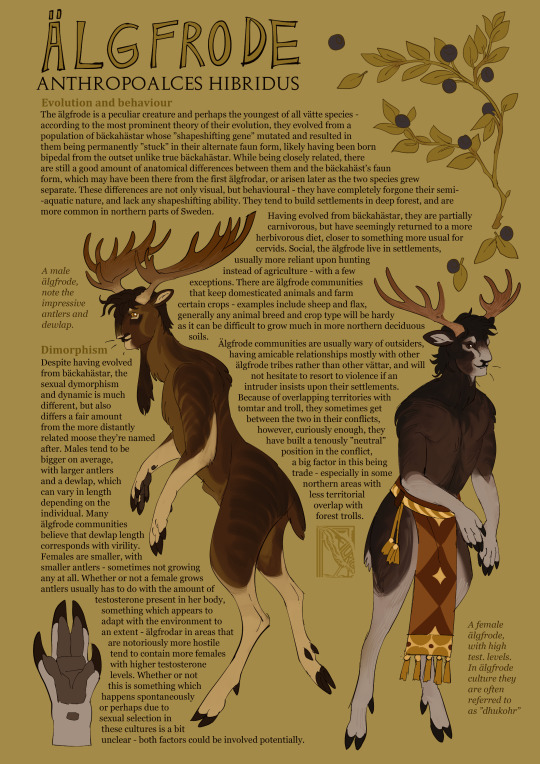
its been a while but new pareidolia creature!! ive been thinking of making these for a while. in case u don't know what an älgfrode is (a bit more of a niche nordic mythology creature), an älgfrode (or elgfróði in icelandic) was mentioned in hrólfs saga kraka, one of the old norse hero sagas. while the context for that was one specific character i just wanted to make moose people..
more info abt my creatures below the cut...
they wear more clothes than in the ref this is just to show their anatomy LOL. clothing is actually very important to them and textiles will almost always have a role in any tradition/significant social event. their textilework is very renowed and is one of the trades that cause some other vättar to want to trade with them as mentioned in the ref!
one potential reason for their high level of defensiveness is that their species suffers from a higher than average infant mortality rate - with time, this mortality rate has lowered from what it used to be, but when the species first appeared, it wasn't unusual for a mother to have to give birth to many calves before one even made it to adulthood. this rooted a deep set vigilance in them - even now that the rates have stabilised a bit. the high mortality rate was probably due to the affected "shift" gene sometimes activating improperly which could result in stillborns. with time and selective pressure new gene mutations would arise in the species that "counteracted" the instability of the first initial one and made the infant mortality decrease. it is, however, still a little higher than usual for similar species, and so it is traditionally encouraged to have many children.
gender roles for älgfroder are interesting - there is a strong sense of "equal strength", or "laorhgr" in älgfrode, which is important. while males are usually slightly larger than females, there is emphasis on the importance on a pair being able to stand their ground both physically and emotionally to the other and a relationship can only go ahead if a spar between two älgfroder is fair. this extends to an interesting dynamic that involves polyamory. älgfroder can be both monogamous and polyamorous, however polyamorous relationships often only arise when there is a big physical differential between two parties. the belief is that if one party is stronger than the other, that strength can be equalised if the other party is accompanied a second partner of similar strength - usually this happens between one strong male and two females on the smaller end. that way the resulting relationship has achieved "laorhgr". this ofc varies as everything does but ya. basically if you are a big strong älgfrode dating a small petite älgfrode it's seen as shameful and barbaric. there is also a bias to heterosexual relationships as it is seen as an important social duty to at least successfully raise one calf.
dhukohr are the more commonly occuring intersex condition in älgfrodar, but there is an equivalent to it for "males" where they fail to grow antlers and have very small dewlaps due to low testosterone levels - those are usually referred to as kvikohr. they are often recognised as their own gender respectively however there are many that identify as men/women too. some of these dhukohr/kvikohr are actually moreso trans than intersex - simply having utilized faerie dust in order to transition. this can be a bit of an ordeal though because usually this requires being administered it by a tomte which, depending on the settlment, can be a tense negotiation, although individuals usually have a less hard time with that.
älgfrodar and bäckahästar can hybridise and do sometimes produce fertile offspring! i would have to think more about this though erm. but i think it does and can happen. there is a sense of rare camraderie between the two species in many cases but especially so between älgfrodar and bäckahäst communities that choose to spend more time as their faun shift than their base shift - in fact a few of these bäckahästar choose to integrate into certain älgfrode settlements, but this is more of a rare occurance. most bäckahästar that possess "unishift" clothing have actually had them made by älgfrodar, or at least had the fabric sourced from them
#pareidolia tag#bestiary#faun#fantasy#speculative fantasy#specbio#speculative biology#speculative evolution#folklore#worldbuilding#creature lore
204 notes
·
View notes
Note
i honestly wish rr would just write for something that has nothing to do with pjo not the same characters not the universe just go and write something new bc i really liked daughter of the deep and i think he's wrung everything out of the pjoverse yk? he's a good writer but he needs to go do something different
I agree - the problem with Rick's writing is he's heavily reliant on his writing being derivative. He struggles to write original stuff. PJO, HoO, ToA, etc are all derivative from Greco-Roman mythology/history. MCGA is Norse mythology/history, TKC is Egyptian mythology/history. Daughter of the Deep is Twenty Thousand Leagues Under The Sea. And he's not terrible at it! The problem is that can't go on forever. He runs out of material to work from over time and suddenly the quality of the franchise tanks dramatically. Especially as he loses overarching connecting threads to tie the plots together, so it just becomes this soup of throwing references at the wall with no cohesion to see what sticks. And it's bad!
We started seeing it in HoO, also in part due to Rick trying to combine too many disparate inspirations to the main plot to begin with and didn't know how to make them mesh well (Seven Against Thebes, Gigantomachy, Argonauts, Odyssey). TKC and MCGA were okay because they're only three book series, so that's plenty of mythology to draw from with stuff left over, and the majority of their companion novel stuff is ghostwritten anyways. The shorter series span means less filler required so less mythology is used up and there ya go. In the longer series, Rick has to spend those five books filling in the gaps of that overarching plot and he runs out of material fast - that's why by the end of HoO it was just turning into blatant Marvel references. Now that we're getting into a fourth installment in the main series collection, even though it's only a three-book series, Rick has basically written himself into a corner because he doesn't write anything else. He ran out of places to go with the franchise like two series ago! So now he's just throwing literally anything he can think of at things (literally just plucking random mythological figures and pop culture references or tropes), or if he can't think of anything, apparently just blatantly lifting stuff from the community.
At this point the only possible Greco-Roman series I think he'd be able to do without it being total garbage would be a 3-book Roman series set during SoM-TLO/The Second Titan War. I don't think he should do that and I don't want him to, but based on everything that's probably just what would have the best likelihood of success. It just seems like the only place he can go. Anything else he'd have to do something actually original, and he's shown time and time again that he's not interested in doing that and isn't very good at it anymore.
#pjo#riordanverse#rr crit#rick riordan#Anonymous#ask#anyways let this be a lesson for ya kids: when your creative writing teacher tells you that you can't just write fanfic all the time#and that you have to write original stuff - this is why. dont be like rick. make sure you are capable of writing original material#because otherwise whenever something bridges too far from what you're deriving it from you'll get Very Lost
100 notes
·
View notes
Text
What Would They Name Their Children? (Headcanons)
2012!Turtles

A/N: Fun fact, my great grandmother was named after Olga of Kyiv. And another fun fact, my grandparents met each other at Niels Bohr institut in Copenhagen.

Warnings: None💚

Leonardo:
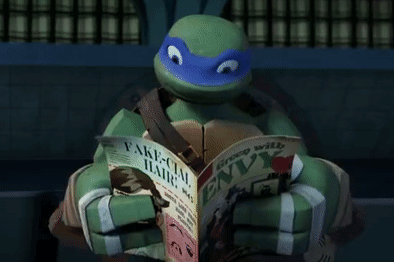
Leo would want to honor his Japanese heritage, in the memory of his father. With a great knowledge of not just Japanese culture and language, but mythology and history, Leo would have more than just a few name ideas for his future children. His future partner may very well have to keep him in check, helping him sort through the all.
For Boys:
Kenji, meaning either “strong and vigorous” or “intelligent second son” in Japanese.
Asahi, meaning “morning sun”, “rising sun” or “sunrise” in Japanese.
Kangiten, the Japanese god of bliss.
For Girls:
Haru, meaning “springtime” in Japanese.
Sanyu, meaning “happiness” in Japanese.
Amaterasu, the name of the Shinto goddess of the sun.
Raphael:

Raph likes strong names. Names that make people think of strong warriors and brave leaders. For that to happen, it needs to be names that most people would know, and be able to recognize with at least a little ease. It won’t work if Raph chose a name no one had heard of before.
For Boys:
Thor, after the Norse god of thunder.
Zeus, after the Greek god of lightning and king of the gods.
Anu, also known as the Sky Father and the King of Gods in ancient Mesopotamia.
For Girls:
Boudicca, after the queen of the Iceni tribe, who led the rebellion against the Roman forces that invaded Britain.
Olga, after Olga of Kyiv, who avenged the murder of her husband at the hands of the Drevlians, while protecting her son.
Lagertha, after the Norse shieldmaiden from Norway.
Donatello:

It would be no surprise to anyone, that Donnie would name his children after some of the great minds that he found himself looking up to. Just like Leo, Donnie would have so many names lined up and ready to go, that his future partner would have to help him sort them all through, before setting on the ones that they would find fitting.
For Boys:
Charles, after Charles Darwin.
Deodatta, after Deodatta V. Shenai-Khatkhate.
Niels, after Niels Bohr.
For Girls:
Rosalind, after Rosalind Franklin.
Barbara, after Barbara McClintock.
Emilie, after Emilie du Chatelet.
Michelangelo:

The names Mikey has lined up for his future children, changes quite a bit in reasoning. Some of them mean something to him, in the sense that he finds the meaning of the name very important. Others are important to him, due to pop culture or, well, food. A simple man with simple thoughts I guess.
For Boys:
Keanu, because of Keanu Reeves of course. Duh.
Ace, from Latin, meaning “one”, “someone who excels” or someone of a high rank.
Bodhi, a Sanskrit name meaning “enlightenment” or “awakening”.
For Girls:
Cherry, which both could be referring to a meaning of “dear one”, but also the fruit.
Clementine, meaning everything from “merciful”, “gentle” and “mild” to the small citrus fruit.
Éowyn, because of Lord Of The Rings, of course.
#tmnt#teenage mutant ninja turtles#tmnt leonardo#tmnt raphael#tmnt donatello#tmnt michelangelo#tmnt raph#tmnt donnie#tmnt mikey#tmnt leo#tmnt headcanons#tmnt 2012#tmnt 2012 headcanons#tmnt 2012 leo#tmnt 2012 leonardo#tmnt 2012 raph#tmnt 2012 raphael#tmnt 2012 donnie#tmnt 2012 donatello#tmnt 2012 mikey#tmnt 2012 michelangelo
180 notes
·
View notes
Note
Hello! Wanted to say I absolutely love your characters, be it the Lotta Girls but also your depictions of the norse gods. Wanted to try my hand in some norse gods and wanted to ask if you ever did any reference of them. (totally not wanting to draw one of them)
Thanks! Glad to hear that you like them. While I don't have any clear reference sheets of the characters, as their designs differ a bit from each drawing, browsing my Norse Mythology-tag gives some results. But since you asked I felt like drawing Jord and Angrboda again, two of my favorites because while they are similar in a way, in design they are quite the opposites.

195 notes
·
View notes
Text
Numerology: The number 9
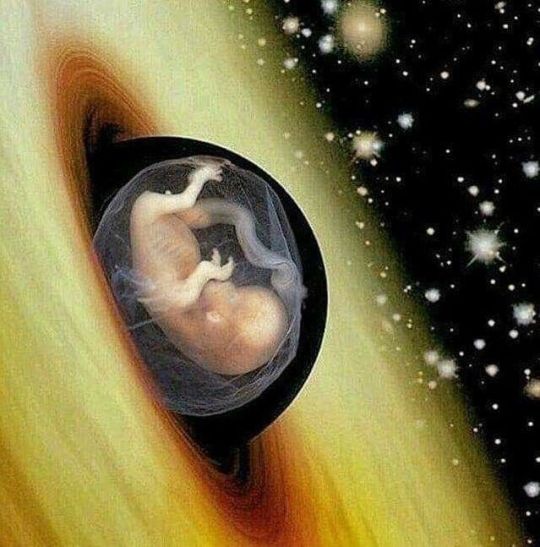
9 18 27 36 45 54 63 72 81 90 99
What does the number 9 signify? 9 means completion, but not a final ending.
In astrology: the number 9 is associated with the planet Mars, which is said to govern ambition, energy, and action. People born under the sign of Mars, which is associated with the number 9, are said to be confident, independent, and adventurous. The ninth sign of the zodiac, Sagittarius, is known for its adventurous and expansive spirit, which reflects the qualities of the number 9. Additionally, the number 9 is linked to the concept of karma, which refers to the idea that our actions have consequences that come back to us. This is because 9 is the result of adding up all the single-digit numbers before it (1+2+3+4+5+6+7+8=36, and 3+6=9), suggesting that we reap what we sow. Overall, the number 9 is significant and powerful in astrology, representing completion, growth, and the consequences of our actions. Moreover, in Vedic astrology, the nine planets or Grahas are believed to have a significant influence on human destiny and are associated with different qualities and energies. These planets include the Sun, Moon, Mercury, Venus, Mars, Jupiter, Saturn, Rahu, and Ketu. The Sun and Moon are considered the most important planets, as they are responsible for life on Earth and are associated with the soul and mind, respectively. The number 9 is associated with the planet Guru or Jupiter, which is considered the most benefic planet in the horoscope. Guru is associated with wisdom, knowledge, and good fortune. People who are born on the 9th, 18th, or 27th of any month are said to be influenced by the planet Guru and are considered to be blessed with good luck and prosperity.
In astronomy: the number 9 is perhaps most famously associated with the nine planets in our solar system. the number 9 has significance in the relationship between the Sun, Moon, and Earth. It is said that the Sun completes a cycle of 360 degrees in the sky in one year, which is divided into 12 zodiac signs, with each sign taking up 30 degrees. The Moon, on the other hand, takes about 29.5 days to complete its cycle around the Earth, and during this time, it passes through all 12 zodiac signs. Interestingly, the total number of days in a solar year (365.24) multiplied by the number of lunar months in a year (12.37) equals 4536.24, which can be reduced to 9. This is known as the lunar-solar cycle, and it is believed to be a powerful symbol of completion and transformation.
In mythology: the number 9 is often associated with spiritual growth and knowledge. For example, in Norse mythology, Odin hung from the world tree Yggdrasil for nine days and nine nights to gain wisdom and knowledge. In Greek mythology, nine muses inspired creativity and art, while in Egyptian mythology, nine gods presided over the underworld.
In mathematics: the number 9 has some unique properties as well. It is the highest single-digit number, and any number multiplied by 9 will always result in a number whose digits add up to 9. Additionally, the number 9 is the sum of the first three square numbers (1² + 2² + 3² = 9) and the sum of the first three cube numbers (1³ + 2³ + 3³ = 36). This property of the number 9 is known as the "digital root" and is used in various mathematical and divinatory practices.
In physics: the number 9 appears in the fundamental equations that describe the behavior of the universe, such as the nine-dimensional equations of string theory. In mathematics, the number 9 is used in a variety of numerical systems, including the base-9 system used by the ancient Maya.
In science: the significance of number 9 in science is reflected in its frequent appearance in various scientific phenomena. For instance, the periodic table has nine fundamental types of atoms, known as lanthanides. The human body is made up of nine major organ systems, including the cardiovascular, nervous, and respiratory systems. The electromagnetic spectrum has nine main categories of waves, ranging from radio waves to gamma rays. Sun and Earth: The diameter of the Sun is supposed to be 108 times the diameter of the Earth. The distance from the Sun to the Earth is 108 times the diameter of the Sun. It looks very dramatic and mysterious yet if true its indeed happy mystery. Moon and Earth: The average distance of the Moon from the Earth is 108 times the diameter of the Moon. Furthermore, there are nine planets in our solar system (including Pluto, which is now considered a dwarf planet), and the number 9 also appears in the fundamental equations that describe the behavior of the universe, such as the nine-dimensional equations of string theory. The number 9 also appears in the concept of tides, which are caused by the gravitational pull of the moon and sun on the Earth's oceans. Tides follow a roughly 12-hour cycle, with high and low tides occurring twice a day, resulting in a total of around 9 tides per day.
In ancient Egypt: the number 9 was associated with the nine gods who ruled over the underworld.
In music: the significance of the number 9 in music is rooted in its harmonic properties. The ninth note of a scale, known as the subtonic, is a crucial note for creating tension and leading to the tonic note. This creates a sense of resolution and closure in musical phrases. Additionally, the number 9 appears in musical time signatures such as 9/8, which adds a unique and complex rhythmic texture to the music. The number 9 also plays a symbolic role in music, as seen in The Beatles' "Revolution 9," a groundbreaking experimental track that features various sound effects and spoken word samples. Overall, the number 9 adds depth and complexity to the music, both in its harmonic properties and its symbolic significance.
Nine Muses: In Greek mythology, the Nine Muses were the goddesses of inspiration in the arts and sciences, such as music, poetry, and astronomy. They were said to be the daughters of Zeus and Mnemosyne and were believed to provide inspiration and guidance to human beings.
Nine Worthies: The Nine Worthies were a group of historical and legendary figures from different cultures who were seen as exemplars of chivalry and virtue. They were divided into three categories of three: pagan, Jewish, and Christian. The pagan worthies were Hector, Alexander the Great, and Julius Caesar; the Jewish worthies were Joshua, David, and Judas Maccabeus; and the Christian worthies were King Arthur, Charlemagne, and Godfrey of Bouillon.
Ennead: In ancient Egyptian mythology, the Ennead was a group of nine gods and goddesses who were worshipped in the city of Heliopolis. The Ennead included the god Atum, who was believed to have created the world, and his children Shu and Tefnut, who represented air and moisture, respectively.
Nine Emperor Gods Festival: The Nine Emperor Gods Festival is a Taoist festival celebrated in Southeast Asia, particularly in Thailand, Malaysia, and Singapore. The festival is held in the ninth lunar month and is dedicated to the worship of the Nine Emperor Gods, who are believed to bring good luck and prosperity.
The 9th letter of the alphabet is "I", which is also the Roman numeral for the number 1. This means that "IX" is 9 in Roman numerals, which is why you sometimes see clocks or watches with "IX" instead of "IX" to represent 9.
Islam: Quran says that each and everything of this universe is counted and surrounded by numeric. The 9th chapter of the Qur'an At-Tawbah 'the Repentance', and is one of the last Medinan surahs. The number 9 is the day of Hajj. The Messenger Mohammad participated in 9 of the conquests. And nine Qur’anic verses speak about the prophet Moses. The Arabic letters of the opening in the Qur’an add up to 786=9, 786 is an Arabic numeric value that denotes“Bismillah al-Rahman al-Rahim” the opening phrase of the Holy Quran. It translates as “In the name of Allah, the Most Merciful, the Most Beneficent“. 786 is basically driven from the series of Arabic Numerology called “Abjad“. In Muslim tradition it is known to be the symbolic representation of Allah. But no Islamic scholar has so far been able to explain the origin of this number. In fact, it is not mentioned in the Quran. Ramadan: a time of fasting and spiritual reflection for Muslims, is the ninth month of the Islamic calendar.
Biblical Symbolism: The number nine is found 49 times in Scripture. Its biblical symbolism is tied mainly to the concepts of finality, divine completeness, and judgment. It typically surfaces during pivotal moments of transformation, culmination, or judgment in the biblical narrative. In the divine order of creation, the Lord chose to create a nine-month gestation period for human beings, indicating a time of completeness before birth. The number nine often marks the end of a divine cycle or period. In the context of the Old Testament, every ninth year represented the end of one cycle and the beginning of a new one. The number 'nine' also weaves a pattern of divine judgment throughout biblical history. For instance, the prophet Hosea, inspired by God, declared that Ephraim's destruction would come to the city in the 'ninth' year. In another instance, the ninth hour was marked for Christ's death, symbolizing the largest divine judgement humanity has ever witnessed. Ezekiel 24:1-2 noted the siege of Jerusalem commenced on the 'ninth' day of the tenth month. Adding to its significance, the city's destruction commenced on the 'ninth' day of the fourth month. Nine Attributes of God: The Lord is patient, The Lord is Merciful, The Lord is Gracious, The Lord is Abundant in Goodness, The Lord is Abundant in Truth, The Lord is Loving, The Lord is Forgiving, The Lord is a God that Judges, The Lord is Just. In Christianity, there are nine fruits of the Holy Spirit, including love, joy, peace, patience, kindness, goodness, faithfulness, gentleness, and self-control.
The number 9 is revered in Hinduism and considered a complete, perfected and divine number because it represents the end of a cycle in the decimal system, which originated from the Indian subcontinent as early as 3000 BC. The number 9 is considered a lucky number in many cultures, including in China and Japan, where it is associated with longevity and good fortune. In numerology, the number 9 is associated with spiritual growth, selflessness, and humanitarianism.
In Hinduism: The number 9 has played a significant role in Indian history, culture, and mythology. In Hinduism, there are nine planets, nine forms of Devi, and nine forms of Lord Vishnu. The number 9 is also associated with the Navratnas, which are the nine precious gemstones. According to Hindu mythology, there are nine avatars of Lord Vishnu, including Matsya, Kurma, Varaha, Narasimha, Vamana, Parashurama, Rama, Krishna, and Kalki. These avatars are believed to have appeared on Earth in different forms and at different times to restore balance and order. The number 9 is also significant in other Indian religions and traditions. In Buddhism: there are nine stages of consciousness. Some Buddhists carve have 108 small Buddhas on a walnut for good luck. Other Buddhists, like in Tibet and in Bhutan, they ring a bell 108 times to celebrate a new year. They believed it as corresponding to 108 virtues to cultivate and 108 defilements to avoid. Chinese Buddhists and in the Taoists 108 bead mala (called su-chu), and has three dividing beads, so the mala is divided into three parts of 36 each. Chinese astrology also believed that there are 108 sacred stars. while in Jainism, there are nine tattvas or principles of reality. The number 9 is also associated with the nine chakras, or energy centers, in the body. Nine Gems: The Navratnas, or nine gems, are considered to be powerful and auspicious in Indian culture. These include diamond, pearl, ruby, emerald, yellow sapphire, blue sapphire, hessonite, cat The significance of the number 9 can also be seen in Indian architecture and art. For instance, the famous Hindu temple, Brihadeeswarar Temple, located in Thanjavur, Tamil Nadu, was built in the 11th century and is known for its unique architecture that features nine stories, representing the nine planets in Hindu mythology. The temple also has nine entrances, nine corridors, and nine sacred tanks, emphasizing the importance of the number 9 in Hindu culture. Another example of the significance of the number 9 in Indian art is the Navarasas or the nine emotions, which are depicted in various forms of art, including dance, music, and theater. The nine emotions are Shringara (love), Hasya (laughter), Karuna (compassion), Raudra (anger), Veera (courage), Bhayanaka (fear), Bibhatsa (disgust), Adbhuta (wonder), and Shanta (peace). These emotions are believed to be the essence of human experience and are often portrayed in Indian art and literature. Furthermore, the number 9 is also believed to have healing properties in Ayurveda, the ancient Indian system of medicine. According to Ayurveda, the human body is composed of nine elements or dhatus, which are Rasa (plasma), Rakta (blood), Mamsa (muscle), Meda (fat), Asthi (bone), Majja (marrow), Shukra (semen), Artava (ovary), and Purisha (feces). These elements are believed to be interconnected and affect each other, and any imbalance in these elements can lead to illness. Ayurvedic remedies often involve balancing these elements to promote health and well-being.
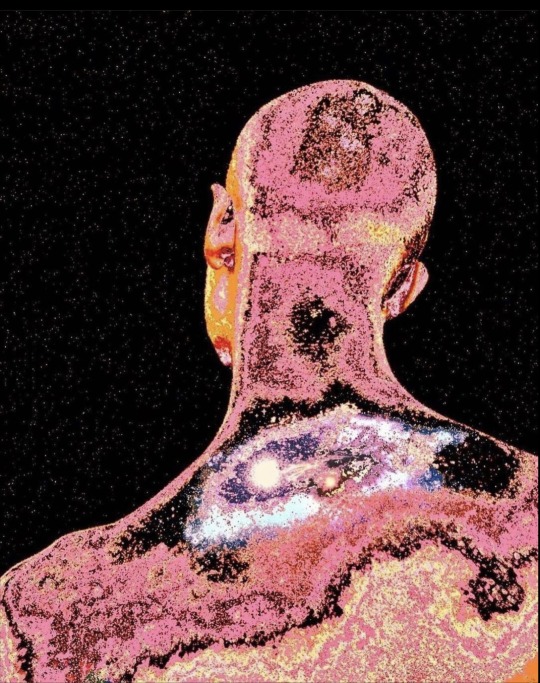
#numerology#vedic astrology#astrology#astronomy#science#greek mythology#hinduism#islam#christianity#bible#holy quran#literature#research#music#ancient egypt#physics#zodiac#zodic signs#astro notes#tarot#chakras#karma#buddhism#jewish#Destiny number#Destiny 9#9 life path#life path#life path 9
59 notes
·
View notes
Text
Alice clues
If you didn't think this show has put an amazing amount of detail into their storytelling methods, may I offer you exhibit A.
This is a scene from episode 2 where we first meet Alice - doing her security gig at Hot Topic. Knowing what we know now... have a look!

Besides the obvious red aesthetic, there are so many little details packed into this one shot! First of all... Have you spotted the ouija planchette yet? (in the upper right corner)
They are telling us her story here!
There are also phases of the moon right by her knee (might be too tiny to see here). The shirt on the left has red skulls all over it and there is a poster of a red skull made out of cobweb - suggestions of death (especially as Aubrey Plaza's end credits have spider as a background). It looks like there is red firey dragon poster behind her too, maybe referring to her being the protection witch.
The image of a man behind her reminds me of Mac Fleetwood, but don't quote me on that. Does anyone recognise it? At first I thought it looked a bit like Jesus (resurrection?) but it's not quite the same.
There is also a sign that says "Time to cash in"... Any ideas of what this could mean other than another death prediction?
Things that make a bit less sense is the shirt to the right - it has mushrooms and fairies on them (and the fairy lights?). The only mention of fairies in the show so far has been when Jen questioned Sharon about the poison effects. "Do you hear the sound of fairies crying?" but I have no idea what that could mean.
There are soooo many different stories and interpretations as to what fairies could symbolise here (e.g. games, growth, deceit, illusions). But I wonder if this is maybe a reference to Fairy realm, or Otherworld, thought to be a parallel dimension ruled by Queen of the Fairies. Historically, there have been women accused of being witches for conversing with the fairies.
I say this because it could work with this next element. There is an image of a raven surrounded by red flowers (towards middle left). You can't quite see it in full here, but when Alice exits the shop, they show it to you again.

Ravens can again symbolise different things. For some they are thought to be harbingers of death. For others they are symbols of transformation. In general though, they are thought to bridge the "chasm between light and shadow" and e.g. in Norse mythology they were messengers between the human world and the divine.
This is even more interesting, because Ali Ahn's end credits have a background of a pentacle with candles around them. AND in a very brief moment, as the pentacle moves into the screen, we can also see the writing "Can you talk to the Dead?"

Now, I know this is a stretch, and more likely than not this is all just a simple reference to the fact that Alice dies in the episode where they try to talk to the dead.
But what if there is a bit more to it and Alice will act as some sort of a messenger for the witches? We know we will see her again according to the promos, but it looks like it will simply be a scene where Rio "wakes her up" to take her body? What will happen to her soul though? (seeing that Rio seems more interested in the bodies) So what if there is more to it?
Even Jac Schaeffer in her latest ep.5 interview, when she confirmed that Alice really is dead, she followed it up with these exact words:
"What I will say is that, it’s not the end of the conversation, is what I would say."
Oh and bonus photo - there even is a red pentacle drawn on the floor of the Hot Topic shop - we see it as Alice gets up to trip Teen when he runs.

#agatha all along#agatha all along spoilers#agatha harkness#kathryn hahn#aubrey plaza#rio vidal#alice wu gulliver#ali ahn
55 notes
·
View notes